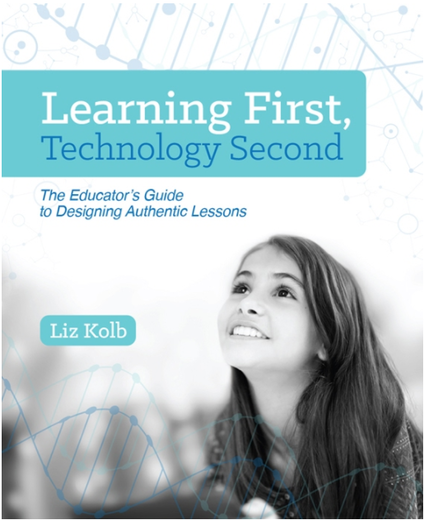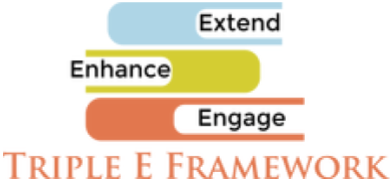|
The #ETCoaches book study of Learning First, Technology Second, The Educator's Guide to Designing Authentic Lessons has just wrapped up and my brain is overflowing with ideas and theories of how to best integrate technology into our educators' teaching and student learning. Liz Kolb, ISTE author and Professor of Edtech at U of M (I had to put aside my college bias, but couldn't deny the incredible work done by her and her colleagues. Go Green!) put together an amazing book and resource that revolves around the Triple E Framework and ISTE standards to think about technology integration to ensure that a teacher and student's learning goals are met. The book brings into context several other frameworks, including two that I've discussed on this blog and with my own staff. TheSAMR and TPACK frameworks definitely have their place in the edtech discussion, but I like how the Triple E Framework is immediately ready to be used as a quick evaluation tool for teachers and administrators to assess a lesson and what technology you may have included to enhance, engage, or extend the learning goals based on your curriculum or standards.
The framework revolves around the three main concepts of engagement, enhancement, and extension.
Engagement in learning goals is the first component or measure of the framework. Just as you would guess the purpose is to look at how any technology tools you are using will help students engage with the desired learning goals and classroom tasks. I thought the books discussion of false engagement is a critical component we need to consider when evaluating our tech use. We cannot assume engagement just because student is using a piece of technology, but we need to ask ourselves if they are active participants in their learning with the aide or addition of technology. The book discusses a variety of strategies to promote engagement including things like guided practice or co-use and provides context for how to think about them in a handful of scenarios where you can think about and visualize the process. Kolb lists the three questions below to ask yourself when measuring the engagement of your learning goals through a tech tool:
1. Does the technology allow students to focus on the assignment or activity with less distraction? 2. Does the technology motivate students to start the learning process of knowledge gathering? 3. Does the technology cause a shift in the behavior of the students, where they go from being passive to active social learners? *Learning First, Technology Second: The Educator's Guide to Designing Authentic Lessons. (2018). 1st ed. [ebook] Portland, OR: International Society for Technology in Education, p.50-51. Available at: https://www.iste.org/resources/product?ID=3975&ChildProduct=4012 [Accessed 1 Feb. 2018].
Enhancement of learning goals is the second element of the framework and has a teacher look at how technology adds value and scaffolds learning for students. Keeping higher-order thinking skills in mind is crucial to thinking about the enhancement a piece of technology can bring to your lesson and help accomplish your lesson goals. The book includes a list of tools/resources that can provide enhancement such as Kaizena and Imagistory with additional description and explanation. The same scenarios are provided from the engagement chapter, but take the questions below into consideration when evaluating a lesson plan with its learning goals:
1. Does the technology tool aid students in developing a more sophisticated understanding of the content (higher-order thinking skills)? 2. Does the technology create scaffolds to make it easier to understand comprehend or demonstrate their understanding of the learning goals in a way that 3. Does the technology create paths for students to comprehend or demonstrate their understanding of the learning goals in a way that they could not do with traditional tools? *Learning First, Technology Second: The Educator's Guide to Designing Authentic Lessons. (2018). 1st ed. [ebook] Portland, OR: International Society for Technology in Education, p.64-65. Available at: https://www.iste.org/resources/product?ID=3975&ChildProduct=4012 [Accessed 1 Feb. 2018].
Extension of learning goals is the third and final component of the framework. The focus is on something I think good educators already know which is learning does not and cannot take place in isolation. If we are not looking at how what we teach our students is connecting to their own lives then how do we expect them to find a value and retain what they are learning. Kolb discusses several tools including GooseChase and Lab4U as ways to extend your students' learning. Like the previous two components of the framework the same learning/classroom scenarios are listed while taking the three questions below into consideration:
1. Does the technology create opportunities for students to learn outside in their everyday lives? 2. Does the technology create a bridge between school learning and everyday life experiences? 3. Does the technology allow students to build skills that they can use in their everyday lives? *Learning First, Technology Second: The Educator's Guide to Designing Authentic Lessons. (2018). 1st ed. [ebook] Portland, OR: International Society for Technology in Education, p.78-79. Available at: https://www.iste.org/resources/product?ID=3975&ChildProduct=4012 [Accessed 1 Feb. 2018].
Understanding the three components and their role in good technology integration is done very well by Kolb in the book. This includes scenarios to understand the components, examples from the field, instructional support strategies, and lesson plan templates. One of the best tools she gives you is the Triple E Measurement tool and access to a free digital version on https://www.tripleeframework.com/ . This has been my first experience with a framework that has a digital resource can be used right away to evaluate a lesson and have quick feedback on where it falls within the framework and its areas of strength and weakness. Take 5 mins and review a lesson you have created with the easy to use rubric HERE and make any adjustments to get the most out of your lesson and accompanying tech resources to best achieve your learning goals.
There you have the tip of the iceberg when it comes to understanding and using the Triple E Framework for effective tech integration. Do yourself a favor and grab a copy of the book and really dive into what the Triple E Framework is all about and how you can begin using it to put some thought behind your tech use in teaching and learning. Better yet, read it with some colleagues to really get a group perspective and avoid learning in isolation. Reach out on Twitter mentioning @TripleEFrame & #ETCoaches and grow your PLN with an amazing group of educators (many whom participated in the recent book study and slow chat). If you have read Learning First, Technology Second please leave any insights in the comment section. Always keep those learning goals first and you'll be amazed at the results!
0 Comments
|
About EvanDirector of Technology for Traverse City Area Public Schools. Level 2 Google Certified Educator. Former Tech Integration Specialist and 4th grade teacher at Aspen School District and Spartan for life! Go Green! Categories
All
Archives
February 2019
|



 RSS Feed
RSS Feed